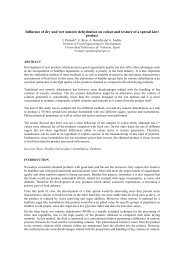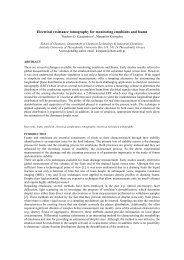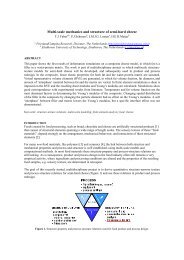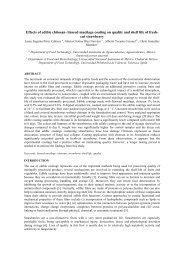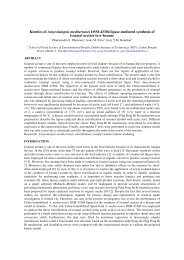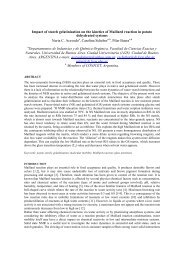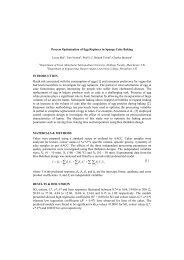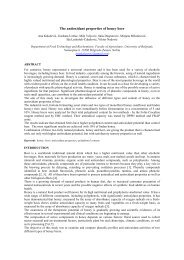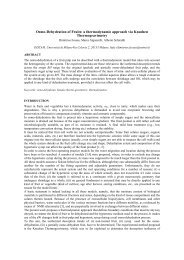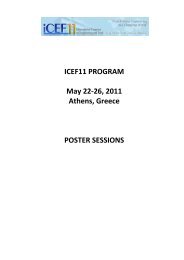Vitamin C Content of Freeze-Dried Tropical Fruits - 11th ...
Vitamin C Content of Freeze-Dried Tropical Fruits - 11th ...
Vitamin C Content of Freeze-Dried Tropical Fruits - 11th ...
You also want an ePaper? Increase the reach of your titles
YUMPU automatically turns print PDFs into web optimized ePapers that Google loves.
preserved because the ascorbic acid is extremely unstable to heat, oxygen, light, pH, moisture content, and<br />
heavy metallic ions (Cu 2+ , Ag + e Fe 3+ ) [2, 5].<br />
In general, quick drying retains larger quantity <strong>of</strong> ascorbic acid (vitamin C) than slow drying. Therefore, the<br />
vitamin C content <strong>of</strong> vegetable tissue is greatly reduced during the sun and hot air drying, whereas during<br />
freeze-drying and spray-drying this loss is reduced [8].<br />
Shadle et al. [9] determined the vitamin C contents <strong>of</strong> carrots after convective and freeze-drying and<br />
observed losses <strong>of</strong> 81.3% and 60.8% in the dried samples for the first and second techniques, respectively.<br />
Yang & Atallah [10] compared the effects <strong>of</strong> freeze drying, forced air, vacuum micro-convection and oven<br />
methods on the quality <strong>of</strong> lowbush blueberries at intermediate moisture (16-25%). Higher vitamin C and<br />
soluble solids retention were observed in the freeze-dried products.<br />
Considering the importance <strong>of</strong> freeze-drying process to fruits preservation, and the high quality <strong>of</strong> dried fruits<br />
that must be <strong>of</strong>fered to the consumers, the aim <strong>of</strong> this work was to determine the vitamin C content <strong>of</strong> fresh<br />
and freeze-dried guava, mango, papaya and pineapple, to evaluate the influence <strong>of</strong> freezing on the vitamin C<br />
retention in freeze-dried fruits and to compare the freeze-drying and convective drying using the vitamin C<br />
content as the quality parameter.<br />
MATERIALS & METHODS<br />
Fresh fruits (guava, mango, papaya and pineapple) were purchased from local market in the city <strong>of</strong> São<br />
Carlos-SP, Brazil. The cores <strong>of</strong> the mango and pineapple samples and the seeds <strong>of</strong> papaya were removed.<br />
The fruits were cut into slices <strong>of</strong> 5 mm thickness and placed in a circular tray with a diameter <strong>of</strong> 125 mm and<br />
height <strong>of</strong> 15 mm and subsequently were frozen in liquid N2. The frozen fruits were dehydrated in a<br />
laboratorial scale freeze-dryer, manufactured by Edwards, L4KR model.<br />
<strong>Freeze</strong>-drying tests were performed with total pressure and temperature inside the vacuum chamber <strong>of</strong><br />
1.3x10 -1 mbar and –30ºC, respectively. One thermocouple probe was used to control and monitor the product<br />
temperature near to the tray bottom during drying. The sublimation heat was supplied by a heating plate<br />
through the tray and the frozen product. The final product temperature during the secondary drying was about<br />
38ºC. The convective drying was performed in forced air oven at 45ºC, 0.6 m/s air velocity, and 42% relative<br />
humidity. Moisture content at a given time was calculated by the ratio between the mass <strong>of</strong> evaporated water<br />
and the bone dry mass, which was determined at the end <strong>of</strong> each experiment by the oven method at (105 ±<br />
3) o C for 24 hours.<br />
The ascorbic acid content <strong>of</strong> “in nature”, freeze-dried and hot air dried pulps was determined using the 2.6<br />
dichlorophenolindophenol titration. About 4.0 g <strong>of</strong> “in nature” sample and 1.2 g <strong>of</strong> dried sample were<br />
homogenized with 50 ml <strong>of</strong> extraction solution (oxalic acid 2%) in a blender for approximately 2 min [11].<br />
An aliquot <strong>of</strong> 10 ml was taken for titration with 2.6 dichlorophenolindophenol. The titration end point was<br />
detected visually and the procedure was repeated ten times for four different samples. Ascorbic acid content<br />
was then determined using the following:<br />
( VT<br />
)( 0,<br />
5 / Vt<br />
)( V )( 100)<br />
( V )( m)<br />
Aa = (1)<br />
a<br />
where Aa is the ascorbic acid content (mg/100g), VT is titration volume (mL), Vt is volume titrationed in<br />
standardization (mL), V is checking volume (mL), Va volume aliquot (mL), and m the sample mass (g).<br />
RESULTS & DISCUSSION<br />
Figure 1 shows the vitamin C content determined for “in nature” tropical fruits and the values found in the<br />
literature. Initially it was verified that “in nature” guava and papaya show vitamin C content lower than those<br />
mentioned in the literature, while the values obtained for pineapple and mango were higher and similar,<br />
respectively, as it can be seen in Figure 1. Regarding this analysis it is necessary to consider the geographic<br />
localization differences from the literature data, EUA, and the fruits studied in this work, Brazil. Nelson et al.<br />
[12] found a range from 19.3 to 71.5 mg/100g AA in six strawberry cultivars from four locations. In addition,<br />
the vitamin C content in fruits can also be influenced by various factors such as genotype differences,<br />
climatic conditions, soil state, maturity at harvest and harvesting methods [1, 2]. The higher the intensity <strong>of</strong><br />
light during the growing season, the greater is vitamin C content in plant tissue [2].



